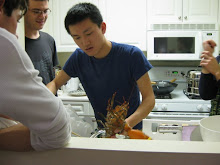The dish is named "Oysters and Pearls": Sabayon of Pearl Tapioca with Malpeque Oysters and Osetra Caviar. It has the distinction of being one of the most expensive dishes in the book to prepare, as the osetra caviar can cost between $65 and $130 an ounce (I opted for the cheaper Californian Osetra, which set me back $65/oz. -- I know, I'm cheap). All of the other ingredients were fairly easy to find; the Malpeque oysters were sourced from The Lobster Place in Chelsea Market. I was also tempted to buy a few Mayan shrimp, which, for those of you who don't know, are gigantic shrimp with heads on, each about the size of a flute. TLP also carries live sea urchins (!) and the most vibrantly alive soft-shelled crabs I have ever seen.
Anyway, here's the mise en place for the sabayon:
 And here's a close-up of the small tapioca pearls:
And here's a close-up of the small tapioca pearls: Aren't they cute?
Aren't they cute?I soaked them in milk for an hour and then rinsed and drained them under cold running water.

I cooked 3/4 cup milk and 3/4 cup cream together in a small pot with the oyster trimmings.
 I brought this to a simmer and drained it. I then poured it over the tapioca pearls in another pot...
I brought this to a simmer and drained it. I then poured it over the tapioca pearls in another pot... I cooked the mixture for 7-8 minutes, adjusted the heat, and cooked for another 5-7 minutes, until it was sticky. Here you can see the tapioca in all its sticky glory:
I cooked the mixture for 7-8 minutes, adjusted the heat, and cooked for another 5-7 minutes, until it was sticky. Here you can see the tapioca in all its sticky glory:
I cooked the egg yolks and 1/4 cup oyster juice in a metal bowl over a pan of hot water, whisking all the time. I poured the hot sabayon over the tapioca mixture, along with freshly cracked black pepper, crème fraîche, and whipped cream. I also added a little salt (but not too much!).
 I put this mixture into five ceramic ramekins, wrapped them in saran wrap, and refrigerated for a few minutes.
I put this mixture into five ceramic ramekins, wrapped them in saran wrap, and refrigerated for a few minutes.Later, I took them out and put them on a baking sheet into the oven at 350 degrees.

Meanwhile, I prepared the sauce. I took some vermouth, oyster juice, shallots, and white wine vinegar and put it in a sauce pan.

I cooked this until it was reduced sufficiently, and the shallots were glazed. I then added eight tablespoons of butter slowly...
Lastly, I added the oysters and chives at the very end.

I took the tapioca/sabayon item out of the oven after about 4-5 minutes. Here they are:
 I spooned the sauce on top along with two oysters (some got three) and garnished with a very healthy amount of Osetra caviar. Here is the finished product:
I spooned the sauce on top along with two oysters (some got three) and garnished with a very healthy amount of Osetra caviar. Here is the finished product:
What an amazing canapé! The sabayon and tapioca was so rich and creamy. The texture of the "pearls" of caviar complemented those of the tapioca. The salinity of the oysters dazzled with those of the sabayon/tapioca.
It was such a decadent dish.
Everyone enjoyed it very much so. I will definitely make it again.
Sources:
Malpeque oysters from The Lobster Place
Osetra caviar from Pescatore
Tapioca and grocery items from The Food Emporium






















































